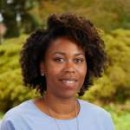Lathiena Nervo
Assistant Professor of Biology
she/her/hers

Phone: 253-535-7376
Email: lnervo@plu.edu
Office Location: Rieke Science Center - 148
Curriculum Vitae: View my CV
- Professional
- Biography
Education
- Ph.D., Developmental Biology, University of Maryland - Baltimore County, 2015
- B.S., Biological Sciences, University of Maryland - Baltimore County, 2004
Selected Presentations
- Manning,L.A., Ronk,H., Sewell, M.,Peifer, M., The scaffold protein Canoe and ZO1/Polychaetoid work together to ensure tissue integrity during tissue formation, 2018 IRACDA Conference, Atlanta, GA (July 2018)
- Manning,L.A., Ronk,H., Sewell, M.,Peifer, M., The scaffold proteins Canoe and ZO1/Polychaetoid help link cell adhesion and the actomyosin cytoskeleton during tissue formation., 2018 Triangle Fly Symposium, Durham, NC (May 2018)
- Manning, L.A., Ronk, H., Peifer, M., The scaffold protein Canoe and ZO1/Polychaetoid help link cell adhesion and the actomyosin cytoskeleton during tissue formation, 59 th Annual Drosophila Research Conference, Philadelphia, PA (April 2018)
Selected Articles
- LA.Manning, KZ Perez-Vale, KN Schaefer, MT Sewell, M. Peifer. "The Drosophila Afadin and ZO-1 homologs Canoe and Polychaetoid act in parallel to maintain epithelial integrity when challenged by adherens junction remodeling." Mol Biol Cell 2019:
- LA.Manning, J. Sheth, S. Bridges, A, Saadin, K. Odinammadu, D. Andrew D, S. Spencer , D. Montell, M. Starz-Gaiano. "A hormonal cue promotes timely follicle cell migration by modulating transcription profiles." Mech Dev 2017:
- LA. Manning and M. Starz-Gaiano. "Upright Imaging of Drosophila Egg Chambers." J Vis Exp 2015:
- LA. Manning, AM .Weideman, B. Moiz, B. Peercy and M. Starz-Gaiano. "Tissue landscape alters adjacent cell fates during Drosophila egg development." Nat Commun 2015:
- LA. Manning and M. Starz-Gaiano. "Culturing Drosophila Egg Chambers and Investigating Developmental Processes through Live Imaging." Methods Mol Biol 2015:
- DP. Stonko, LA. Manning, M. Starz-Gaiano, B. Peercy. "A mathematical model of collective cell migration in a three-dimensional, heterogenous environment." PLoS One 2015:
Accolades
- NIH Seeding Postdoctoral Innovators in Research and Education (SPIRE) Fellowship
Professional Memberships/Organizations
Biography
My discipline of interest is developmental biology, which is the study of the processes needed for animals and plants to grow and develop. Developmental Biology is an excellent field that intersects, genetics, cell biology, molecular biology, physiology and comparative anatomy to answer key organismal growth questions. My research specifically focuses on how organisms build tissues during animal embryo development. Building the animal body and maintaining tissue homeostasis (equilibrium) requires the coordinated effort of many cells acting in concert. Controlling these concerted cell movements are the cell adhesion and cytoskeletal machinery, which work together to provide cells, tissues, and organs with correct architecture and allow them to change shape and move in coordinated ways. Understanding the basic molecular machinery that allows cells to interact and affect tissue formation is not only a matter of enormous importance for developmental biology but of the fields of cancer biology, cell biology, and genetics, among numerous other areas of inquiry. I have focused on understanding the mechanisms regulating the interaction between cytoskeletal and adhesion molecules while shaping epithelial tissue architecture. During embryonic development, tissue establishment is made possible by cell shape changes and migration. Defects in these processes are the cause of disruption during developmental processes like neural tube closure, disfiguring skin diseases and congenital defects of the ear, vasculature and palate (ex: cleft palate). Currently, my research has focused on defining the molecular machinery that drives how cytoskeletal rearrangements during cell migration, cell shape changes and cell-cell interactions affect tissue formation. My research combines developmental biology, cellular biology and genetics and uses embryo development in the fruit fly, Drosophila melanogaster (Drosophila) to determine how individual cell behaviors can affect 3 dimensional tissue architecture.



Social Media